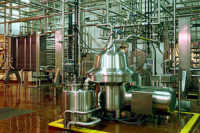The cases were centered in the local Hispanic population of Los Angeles. These were “confirmed” cases; however, the actual number is estimated to be significantly higher. The outbreak was eventually linked to Jalisco Mexican Products Inc., commonly known as “Jalisco Cheese.” Investigators determined that an unknown portion of the milk used to make the company’s fresh Mexican-style cheeses was not pasteurized. This was not by mistake. Raw milk added to pasteurized milk enhanced the flavor of the cheese, giving it a slight rancid flavor.
At the time, we knew virtually nothing about Listeria. We were asking:
- What is it and how pathogenic is it?
- Where did it come from?
- How does it grow?
- Can we control it?
But the most important questions in 1985 were: Will sanitizers destroy it and does it survive pasteurization?
Listeria hysteria is long gone
In general, this outbreak caused a panic in the dairy industry and was termed the “Listeria Hysteria.” People were shocked and amazed that this could happen.
Today, Listeria is still a major issue in the food and dairy industry, even though it probably is our most studied pathogenic bacterium. We now know that:
- There are at least two pathogenic species of Listeria, L. monocytogenesand L. ivanovii. Therefore, control efforts in operations must focus on all Listeria, not just L. monocytogenes.
- Listeria is commonly present in raw milk. Separation of raw and pasteurized product is essential for control.
- Listeria is also commonly present in the general environment. We must follow good manufacturing practices and use floor foamers to sanitize our footwear.
- Normal refrigeration, at temperatures between 34 to 40 F, will not stop Listeria’s growth because they are psychotropic pathogens. This finding was earth-shaking and means that coolers and conveyors need to be cleaned and sanitized, as well as the processing areas.
- When on a surface, Listeria will quickly form a tenacious bio-film. The presence of this bio-film necessitates the need for very vigorous cleaning to expose the viable microbial cell to a sanitizer. It has now been proven that sanitizers in use today are effective against Listeria, when used as directed.
The bottom line is that controlling Listeria is not an issue of sanitizer effectiveness but of effective cleaning.
Time, temperature do their work
In the years immediately following 1985, there were several studies trying to determine if Listeria survived pasteurization as defined in the Pasteurized Milk Ordinance. For white milks, the PMO sets vat pasteurization at ≥ 145 F for a minimum of 30 minutes and HTST pasteurization at ≥ 161 F for a minimum of 15 seconds.
Incredibly, a few of the early studies indicated that Listeria, in fact, would survive pasteurization. This was appalling. Not only was Listeria common in raw milk and would grow under refrigeration but now we had to ask: Might it survive pasteurization? Fortunately, we now know that pasteurization does indeed control Listeria. Thus, stopping post-pasteurization contamination becomes eminently important.
Today, it is known that Listeria can be controlled — but not eliminated — in dairy processing plants. By using vigorous cleaning and sanitizing, GMPs and incorporating an aggressive environmental Listeria monitoring program, this very bad bug can be controlled.
For More Information |
|
Learn more about Randolph Associates Inc.’s training programs, products and technical expertise by visiting www.raiconsult.com. Sign up for the following training courses:
For registration and additional information, contact Kristy Clark at 205-595-6455 or email kristy.clark@raiconsult.com. |



